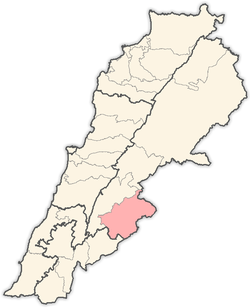Ain Aata
Ain Aata, Ain Ata, 'Ain 'Ata or Ayn Aata is a village and municipality situated southwest of Rashaya, 99 kilometres (62 mi) south-east of Beirut, in the Rashaya District of the Beqaa Governorate in Lebanon.[2]
Ain Aata Ain Ata, 'Ain 'Ata, Ayn Aata | |
|---|---|
Village | |
| Country | |
| Governorate | Beqaa Governorate |
| District | Rashaya District |
| Area | |
| • Total | 22.40 sq mi (58.02 km2) |
| Elevation | 4,360 ft (1,330 m) |
_p177_CEDARS.jpg) Cedars, in the hills of Ain Aata (2 June 1860)[1] | |
 Shown within Lebanon | |
| Alternative name | Ain Aata, 'Ain 'Ata, Ayn Aata |
|---|---|
| Location | 99 kilometres (62 mi) east of Beirut |
| Region | Rashaya |
| Coordinates | 33.436390°N 35.779446°E |
| History | |
| Cultures | Roman |
| Site notes | |
| Condition | Ruins |
| Public access | Yes |
The name is thought to mean "gift spring".[3] There is a remarkably cold spring in the area.[1]
The village was suggested by Charles William Meredith van de Velde to be the ancient site of Beth-Anath or Anatha mentioned in the Bible Book of Joshua (Joshua 19:38) and the Book of Judges (Judges 1:33) as a land given to Naphtali. Historical geographer Ze'ev Safrai, disputing, identifies the biblical Beth-Anath with Bi'ina in the Beit HaKerem Valley of Upper Galilee.[4][5] Eusebius, in his Onomasticon, placed it 9 miles (14 km) from Dora (Tanturah), however this falls outside the territory of Naphtali.[2][6] Beth-Anath has been translated to mean "temple of Anat", a Canaanite goddess linked to a Sumerian predecessor called Ninhursag.[7]
Roman temple
Recent epigraphic surveys have confirmed the ruins of a Roman temple and cult site in the village that are included in a group of Temples of Mount Hermon.[8][9][10][11] Foundations and columns of a ruined temple complex in the woods near the village were recorded by William McClure Thomson, who thought them to have once been called Kubrikha. He remarked that "the whole neighborhood is crowded with ancient but deserted sites."[6]
References
- Harvey, 1861, p. 145 ff
- Kitto, 2003, p. 344–
- Royal Geographical Society (Great Britain), 1837, p. 98–
- Safrai, 1985, p. 62
- Safrai, 1976, pp. 18–34
- Thomson, 1859, p. 315
- Naʼaman, 2005, pp.248 ff
- Kaizer, 2012, p. 76 ff
- Mouterde, 1951–1952, pp. 19–89
- Robinson and Smith, 1857, p. 438 ff
- Stanley, 1871, p. 408 ff
Bibliography
- Harvey, Annie Jane (1861). Our Cruise in the Claymore, with a Visit to Damascus and the Lebanon. Elibron.com. p. 145. ISBN 978-1-4021-3492-0.
- Kaizer, Ted (2008). Aliquot, Julien., Sanctuaries and villages on Mount Hermon in the Roman period in The Variety of Local Religious Life in the Near East in the Hellenistic and Roman Periods. BRILL. p. 76. ISBN 978-90-04-16735-3.
- Kitto, J. (2003). Encyclopedia of Biblical Literature. Kessinger Publishing. p. 344. ISBN 978-0-7661-5979-2.
- Mouterde, R. (1951–1952). "Antiquités de l'Hermon et de la Beqâ". Mélanges de l'Université St. Joseph. 29: 19–89.
- Naʼaman, Nadav (2005). Canaan in the 2nd Millennium B.C.E. Eisenbrauns. p. 248. ISBN 978-1-57506-113-9.
- Thomson, W,M. (1859). The Land and the Book: Or, Biblical Illustrations Drawn from the Manners and Customs, the Scenes and Scenery, of the Holy Land. 1 (1 ed.). New York: Harper & brothers.
- Robinson, E.; Smith, E. (1857). Later Biblical researches in Palestine, and in the adjacent regions: a journal of travels in the year 1852. Crocker and Brewster. p. 438.
- Royal Geographical Society (Great Britain) (1837). The journal of the Royal Geographical Society of London. J. Murray. p. 98.
- Safrai, Z. (1976). "Beth-Anath". Sinai (in Hebrew). Jerusalem: Mossad Harav Kook. 78: 18–34.
- Safrai, Z. (1985). Chapters of Galilee, During Mishnaic and Talmudic Times: Pirkei Galil (in Hebrew). Jerusalem. p. 62.
- Stanley, A.P. (1871). Sinai and Palestine: in connection with their history. J. Murray. pp. 408–. Retrieved 22 September 2012.
